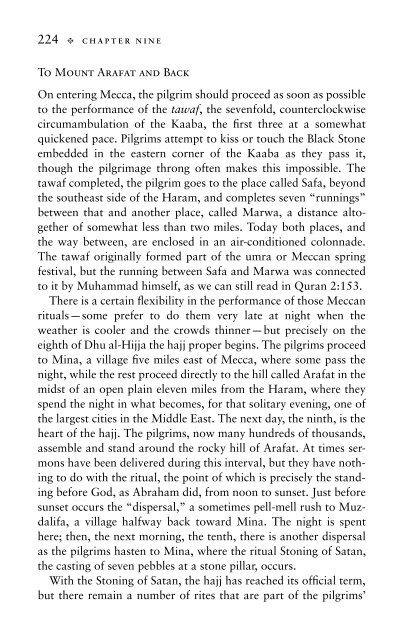Islam: A Guide for Jews and Christians - Electric Scotland
Islam: A Guide for Jews and Christians - Electric Scotland
Islam: A Guide for Jews and Christians - Electric Scotland
You also want an ePaper? Increase the reach of your titles
YUMPU automatically turns print PDFs into web optimized ePapers that Google loves.
224 t CHAPTER NINE<br />
To Mount Arafat <strong>and</strong> Back<br />
On entering Mecca, the pilgrim should proceed as soon as possible<br />
to the per<strong>for</strong>mance of the tawaf, the sevenfold, counterclockwise<br />
circumambulation of the Kaaba, the first three at a somewhat<br />
quickened pace. Pilgrims attempt to kiss or touch the Black Stone<br />
embedded in the eastern corner of the Kaaba as they pass it,<br />
though the pilgrimage throng often makes this impossible. The<br />
tawaf completed, the pilgrim goes to the place called Safa, beyond<br />
the southeast side of the Haram, <strong>and</strong> completes seven “runnings”<br />
between that <strong>and</strong> another place, called Marwa, a distance altogether<br />
of somewhat less than two miles. Today both places, <strong>and</strong><br />
the way between, are enclosed in an air-conditioned colonnade.<br />
The tawaf originally <strong>for</strong>med part of the umra or Meccan spring<br />
festival, but the running between Safa <strong>and</strong> Marwa was connected<br />
to it by Muhammad himself, as we can still read in Quran 2:153.<br />
There is a certain flexibility in the per<strong>for</strong>mance of those Meccan<br />
rituals—some prefer to do them very late at night when the<br />
weather is cooler <strong>and</strong> the crowds thinner—but precisely on the<br />
eighth of Dhu al-Hijja the hajj proper begins. The pilgrims proceed<br />
to Mina, a village five miles east of Mecca, where some pass the<br />
night, while the rest proceed directly to the hill called Arafat in the<br />
midst of an open plain eleven miles from the Haram, where they<br />
spend the night in what becomes, <strong>for</strong> that solitary evening, one of<br />
the largest cities in the Middle East. The next day, the ninth, is the<br />
heart of the hajj. The pilgrims, now many hundreds of thous<strong>and</strong>s,<br />
assemble <strong>and</strong> st<strong>and</strong> around the rocky hill of Arafat. At times sermons<br />
have been delivered during this interval, but they have nothing<br />
to do with the ritual, the point of which is precisely the st<strong>and</strong>ing<br />
be<strong>for</strong>e God, as Abraham did, from noon to sunset. Just be<strong>for</strong>e<br />
sunset occurs the “dispersal,” a sometimes pell-mell rush to Muzdalifa,<br />
a village halfway back toward Mina. The night is spent<br />
here; then, the next morning, the tenth, there is another dispersal<br />
as the pilgrims hasten to Mina, where the ritual Stoning of Satan,<br />
the casting of seven pebbles at a stone pillar, occurs.<br />
With the Stoning of Satan, the hajj has reached its official term,<br />
but there remain a number of rites that are part of the pilgrims’
















